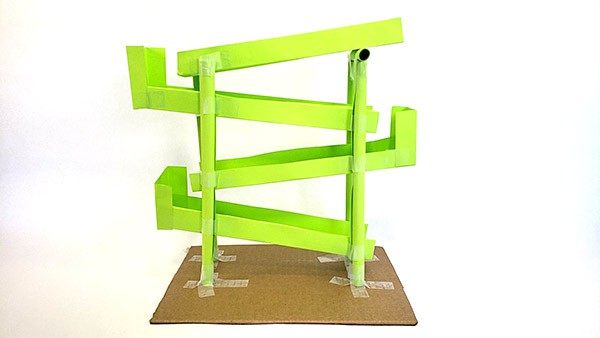Abstract
In this engineering challenge, you will build a ball run from paper and tape, but there’s a twist! You want to make your ball run as slow as possible. How long can you make it take for the ball to get from the entrance to the exit? You can see how other students have tackled this and other annual Science Buddies Engineering Challenges.
Summary
Very Short (≤ 1 day)
None
Readily available
Very Low (under $20)
Ben Finio, PhD, Science Buddies
This engineering challenge is based on an internal competition designed by employees at Fluor Corporation.
Objective
Build a ball run that takes as long as possible for the ball to travel from the entrance to the exit.
Introduction
You might know them by different names: ball run, marble run, ball machine, or rolling ball sculpture. Whatever you call them, these devices start out with at least one ball at the top, and the ball works its way to the bottom as it rolls, bounces, and travels through various features and obstacles (Figure 1).
This Engineering Challenge is inspired by ball runs like those in Figure 1. As shown in the following video, your goal is to build a ball run using only paper and tape, but there’s a twist. You want to make the ball take as long as possible to make it through your ball run.
You can use this project to explore several topics in physics and engineering. Rather than explain each topic in detail, this Background section will give you a brief overview, and you can do more research on your own or use the links in the Bibliography.
- Kinematics is the study of motion. How are quantities like distance, time, and velocity related? What do they have to do with the ball’s path and how long it takes to travel through your machine?
- Your ball run uses different forms of energy. The ball has gravitational potential energy when it is placed at the top of the machine. Some of this energy is converted to kinetic energy (the energy of motion) as the ball gains speed. Some of this energy is lost to friction and converted to thermal energy (heat) as the ball moves. When the ball collides or bounces off something, some of the kinetic energy is converted to other forms, like acoustic energy (sound).
- Your ball run might make use of different simple machines, like levers, inclined planes (ramps), or even a wheel and axle. How can you incorporate different simple machines into the design of your ball run? How can they slow the ball down?
- If you make your ball run taller, it can take longer for the ball to travel through it. However, building a taller ball run can be difficult. It needs to be sturdy so it does not fall over. For example, you might need to connect beams in triangular shapes to form trusses to support a tall ball run.
- You can use this project to practice the engineering design process. You will need to design, build, and test your ball run, and then change it or make improvements, and test again. This process is called iteration.
Terms and Concepts
- Kinematics
- Distance
- Time
- Velocity
- Energy
- Gravitational potential energy
- Kinetic energy
- Friction
- Thermal energy
- Acoustic energy
- Simple machine
- Lever
- Inclined plane
- Wheel and axle
- Beam
- Truss
- Engineering design process
- Iteration
Questions
- How can you build a basic ball run with paper and tape?
- How can you slow the ball down, or make it take longer to travel through the ball run?
Materials and Equipment
If you want to compare your results to those of other students who did the 2022 Engineering Challenge, you can only use the materials listed below.
- Construction materials
- Paper (maximum 30 sheets). Printer, construction, graph, and notebook paper are allowed (letter or A4 size; 9″ x 12″ or 22 x 30-cm construction paper also allowed). Cardstock and newspaper are not allowed.
- Tape (maximum one roll), maximum 1″ (2.5 cm) wide. Clear office tape (e.g. Scotch®), masking, and painter’s tape are allowed. Double-sided tape, duct tape, and packing tape are not allowed.
- Flat surface, such as floor, table, or countertop
- Tools
- Scissors
- Ruler
- Pencil
- Tape measure or meterstick
- Stopwatch
- Ping pong ball, also known as a table tennis ball (1)
- Lab notebook
Experimental Procedure
The objective of the Paper Ball Run Challenge is to build a ball run that takes as long as possible for the ball to get from the entrance to the exit of the run. Figure 2 shows several examples. If you have not already done so, watch the video for an overview of the challenge before you proceed.
- The run must stand on a flat horizontal surface like the floor or a table/countertop/desk/ piece of cardboard. It can be taped to this surface. It cannot be taped to or supported by anything else (the ceiling, walls, furniture, a person, etc.).
- The run must have both an entrance point and an exit point for the ball.
- The entrance point is where the ball is placed into the run. It must be at least 10 inches (25 cm) above the supporting surface.
- The exit point is where the ball exits the run. It must be at least 1 inch (2.5 cm) above the surface.
- The ball cannot be modified in any way or have anything attached to it.
- The ball must be gently placed into the run to start. It cannot be dropped from above the run, thrown, flicked, etc.
- Time starts when the ball is placed in the run and ends when the ball exits the run.
- After the ball has entered the run, you cannot touch the ball or the run, or influence their motion in any way (e.g., by blowing on the ball, shaking the table, or tilting the run, etc.).
- If the ball gets stuck in the run, you must remove the ball and start over. A ball is considered stuck if it does not move for more than 10 seconds.
Design
Before you start building anything, it is a good idea to brainstorm different designs. Try sketching your designs out on paper (paper used for sketching does not count toward the total used to build your ball run). Remember that there is a potential trade-off in your design. Your score depends on both how long it takes the ball to travel through your ball run and how much paper you use. While it will make the ball take longer if you make your ball run taller or add more obstacles to slow the ball down, it will also use more paper. Can you use paper efficiently to make your ball run take as long as possible? Note that you can cut the paper, but the amount of paper you use is rounded up to the nearest whole sheet.
Build
Once you have decided on a design, it is time to start building. You might want to build your ball run from the bottom up, testing different sections as you built it to make sure the ball does not get stuck and making sure the ball run does not collapse. Your design might not work as you planned, and this is OK! Engineers do not always get things right on the first try. If your ball run does not work like you thought it would, you can modify it or even go “back to the drawing board” and start over with a new design. Only paper used in your final design counts when calculating your score.
Test
When you have completed your ball run, test it by gently placing the ping pong ball in the entrance, then letting go. Watch the ball to see if it makes it all the way to the exit of the ball run without getting stuck for more than 10 seconds. What do you observe? Are there places where you can add or change things to slow the ball down even more? When you are done testing, make sure you count the total number of sheets of paper used in your final design
Official Test
When you are ready to do the official test, follow these steps:
- Get your stopwatch ready. A volunteer can help with this step.
- Place the ball in the ball run. Start the stopwatch as soon as you let go of the ball.
- Watch the ball carefully. Stop the stopwatch as soon as the ball exits the ball run.
Scoring
Calculate your score using this equation:
Remember that the number of sheets of paper is equal to the number used in your final design, rounded up to the nearest whole sheet. Paper used in earlier prototypes or for sketches does not count.
If your ball run takes more than one minute, you will need to convert from minutes to seconds before calculating your score. You can do so using this equation:
For example, a time of 1 minute and 30 seconds (1:30) is 60×1 + 30 = 90 seconds.
Ask an Expert
Do you have specific questions about your science project? Our team of volunteer scientists can help. Our Experts won’t do the work for you, but they will make suggestions, offer guidance, and help you troubleshoot.
Global Connections
The United Nations Sustainable Development Goals (UNSDGs) are a blueprint to achieve a better and more sustainable future for all.
Variations
If you enjoyed this project, check out these similar projects, where you can use a marble instead of a ping pong ball. These projects are not eligible for the 2022 Engineering Challenge.
Frequently Asked Questions (FAQ)
Q: Can I use materials not listed in the Materials section?
Q: Can I use other tools?
A: To keep the competition fair, you can only use the tools listed in the Materials section.
Q: Am I allowed to cut the paper?
A: Yes, you are allowed to cut the paper. However, remember that the amount of paper you use is rounded up to the nearest whole sheet when calculating your score.
Q: I used and then discarded some paper while testing different designs. Does the discarded paper get subtracted from my final score?
A: No, only the paper that is used in your final design is included in your final score.
Q: Can I do multiple tries for the official test?
A: Yes. You can test your ball run (and keep tweaking it) as many times as you want, but you can only submit one score.
Q: My ball run broke during a test. Can I fix it?
A: Yes, but you must start the test over and restart your stopwatch.
Q: Is there a maximum time allowed for the ball run?
A: No, as long as the ball does not get stuck in one place for more than 10 seconds.
Q: Are there any limits on the size of my ball run?
A: No, the ball run can be as wide, long, and tall as you want.
Q: Should we round our time to the nearest second, or round our final score to the nearest whole number?
A: No. Please use the exact time when calculating your score. Scores can be submitted with up to two decimal places.
Careers
If you like this project, you might enjoy exploring these related careers:
Career Profile
If you turned on a faucet, used a bathroom, or visited a public space (like a road, a building, or a bridge) today, then you’ve used or visited a project that civil engineers helped to design and build. Civil engineers work to improve travel and commerce, provide people with safe drinking water and sanitation, and protect communities from earthquakes and floods. This important and ancient work is combined with a desire to make structures that are as beautiful and environmentally sound, as they…
Career Profile
Mechanical engineers are part of your everyday life, designing the spoon you used to eat your breakfast, your breakfast’s packaging, the flip-top cap on your toothpaste tube, the zipper on your jacket, the car, bike, or bus you took to school, the chair you sat in, the door handle you grasped and the hinges it opened on, and the ballpoint pen you used to take your test. Virtually every object that you see around you has passed through the hands of a mechanical engineer. Consequently, their…
Career Profile
Our universe is full of matter and energy, and how that matter and energy moves and interacts in space and time is the subject of physics. Physics teachers spend their days showing and explaining the marvels of physics, which underlies all the other science subjects, including biology, chemistry, Earth and space science. Their work serves to develop the next generation of scientists and engineers, including all healthcare professionals. They also help all students better understand their…
Related Links
News Feed on This Topic

Cite This Page
General citation information is provided here. Be sure to check the formatting, including capitalization, for the method you are using and update your citation, as needed.
MLA Style
Finio, Ben.
“Paper Ball Run Challenge.” Science Buddies,
20 Dec. 2022,
https://www.sciencebuddies.org/science-fair-projects/project-ideas/CE_p030/civil-engineering/paper-ball-run-challenge?from=Blog.
Accessed 30 Apr. 2024.
APA Style
Finio, B.
(2022, December 20).
Paper Ball Run Challenge.
Retrieved from
https://www.sciencebuddies.org/science-fair-projects/project-ideas/CE_p030/civil-engineering/paper-ball-run-challenge?from=Blog
Last edit date: 2022-12-20
Explore Our Science Videos
Underwater Color Bursts – STEM Activity





